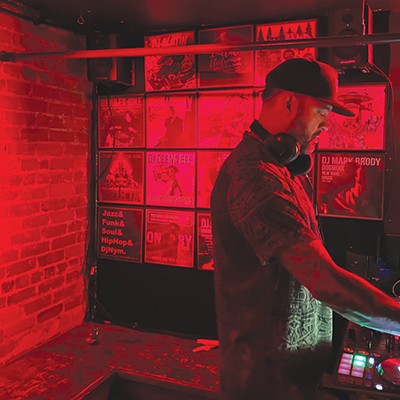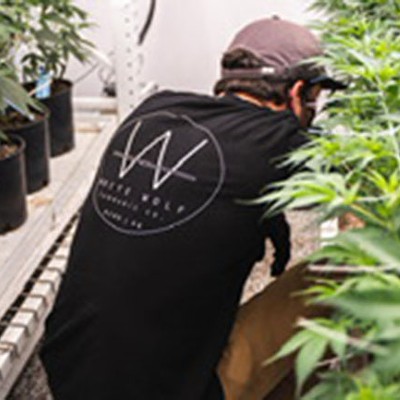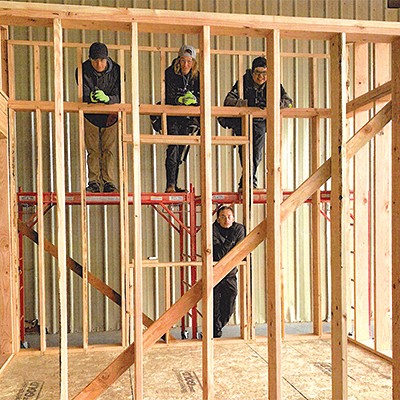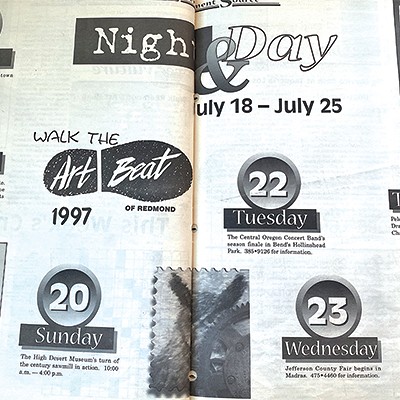Last Wednesday, as the final Bend Farmers' Market of the year was wrapping up, cop cars spilled into the parking lot between Brooks Street and the top of Drake Park. Before long, officers had surrounded a young, black man and brought him to the ground. Onlookers, unaware of any crime and unable to see clearly what was happening beyond the booths and cars, began to worry and to speculate.
One witness, who declined to be named, says she was working at a booth when she noticed a group of police officers. Though vehicles obstructed her view of the officers from the upper thighs down, she says she was worried they were kicking the man and treating him more roughly because of his race.
"I can't confirm what was happening below that line, but it looked like they were being rough. I tried to get up higher on the wall to see because something felt really wrong at that point," she says. "A lot more cops started showing up over the next few minutes. Way too many for arresting one person."
Paul Arney, a local business owner who was in the area for a meeting, was likewise taken aback by the heavy police presence.
"I saw cop car after cop car after cop car," Arney recalls. "I was wondering if somebody got shot or something."
Bend Police Chief Jim Porter says that use of force in arrests is indeed uncommon. In 2013, only about one in every 50 arrests included force. But with the media attention surrounding the police shooting of unarmed black teen Michael Brown in the St. Louis suburb of Ferguson, the use of force—particularly against African Americans—is understandably subject to heightened scrutiny.
In cell phone video provided to the Source, a young, black man can be seen resisting, thrashing his body and jumping up and down. Eventually, officers take him to the ground as the man screams expletives at the officers, saying that he hasn't done anything. In the background, someone encourages the man to remain calm, while others express concern about his treatment by police.
Police say the suspect is 19-year-old Courtney Cornis, arrested and charged Oct. 8 with minor in possession of alcohol, interfering with a police officer, disorderly conduct II and resisting arrest. What started as an attempt to issue a simple citation, police say, escalated into a confrontation requiring backup when, according to police, Cornis "lunged" at the female officer who was checking his identification and began making threats.
We talked to Chief Porter about how officers decide when to use force, what kind of training they receive with regard to race, and how the use of cell phone video impacts their job.
Source Weekly: What are the Bend PD's policies with regard to use of force?
Chief Jim Porter: Bend Police officers are trained to use a reasonable amount of force, based upon the totality of the situation they are confronted with. This use of force ranges from their presence to the use of deadly physical force. Use of force situations are fluid, they can begin as a mere contact and escalate into a life and death encounter in seconds.
SW: How are police trained to respond to a suspect who is resisting arrest and/or intoxicated?
JP: It is important to remember as a rule it is the actions of the subject being encountered by the police that defines the amount of force used by the officers. Officers are trained to use the reasonable amount of force necessary to complete their task at hand. If allowed by the circumstances, officers will begin by attempting to de-escalate the situation verbally. Often the person who is intoxicated on controlled substances or alcohol is not open to de-escalation and the officer will have to use additional force. The majority of these encounters are the result of officers responding to a report the suspect is causing disturbances, has been involved in an altercation, or has made threats towards others. Those individuals who officers are forced to use force to apprehend have through actions or words brought the officers to them. With the dramatic increase in the numbers of individuals of mental health issues on our streets and with the reemergence of serious mood altering drugs, officers are more and more being faced with individuals who are not open for verbal de-escalation, but pose a danger to the public, themselves, and the officers they encounter.
SW: What kind of training do Bend PD officers receive regarding race and racism?
JP: Officers of the Bend Police Department participate in yearly training on issues of race and profiling. After the completion of training the officers are tested on their knowledge on these issues.
SW: How would you define "police brutality" or excessive use of force? How can witnesses tell if police behavior crosses the line, and how should they respond?
JP: Excessive force is defined as the unlawful use of force. Unlawful use of force has been defined as the excessive use of force beyond what is reasonably needed to complete the officer's task at hand. Reasonableness has been defined by the courts and is generally interpreted as based upon the totality of the circumstances, what the officer knows and believes at the time of the encounter, and is often based upon the officer's training and experience...
As to how a person would know when the unlawful use of force is occurring, would be based upon that person's own experience and personal standards. Generally, if the circumstance of the police actions shocks the individual's conscious, then they should report the incident.
SW: In Wednesday's arrest, the suspect was initially approached for something relatively minor—a minor in possession (MIP) citation. How did it escalate to the point where multiple officers are holding someone down? JP: What I can tell you about last Wednesday's incident is independent witnesses describe the suspect as trying to evade the police [and] attempting to walk away as the officers were attempting to issue him a citation. He was yelling sexually demeaning and offensive slurs at female officers, refusing to provide officers with his name and was [described] as acting "crazy and irrational" by witnesses. He was challenging officers to a fight, and threating to catch officers in a dark alley later. Witnesses also state they observed the suspect lunging at officers and attempting to slap officers, resulting in the officers restraining him.
The suspect may be a reasonable person when he is not intoxicated, but Wednesday witnesses and his own family members who responded to the park stated they felt he was under the influence of intoxicants. Witnesses and officers both agreed he was aggressive and lunging at officers, reaching out to slap an officer in the face whose only intent, which they clearly explained to him, was to issue him a citation.
SW: These days, most people have video cameras on their phones. How does that change the way your officers do their job? Is it a help or a hindrance?
JP: Cameras are a good thing in our opinion and a good thing for law enforcement and the public in general. They give the average citizen, the jury, and the judges a peek into the world of violence and aggression officers work in, provide a real-time vision of incidents, and frankly, if the officer and the citizen know they're being recorded they behave better.
We have secured the funding to purchase on-body cameras for all officers at the Police Department. Our target is to have all officers equipped with on-body cameras by January 1.



























